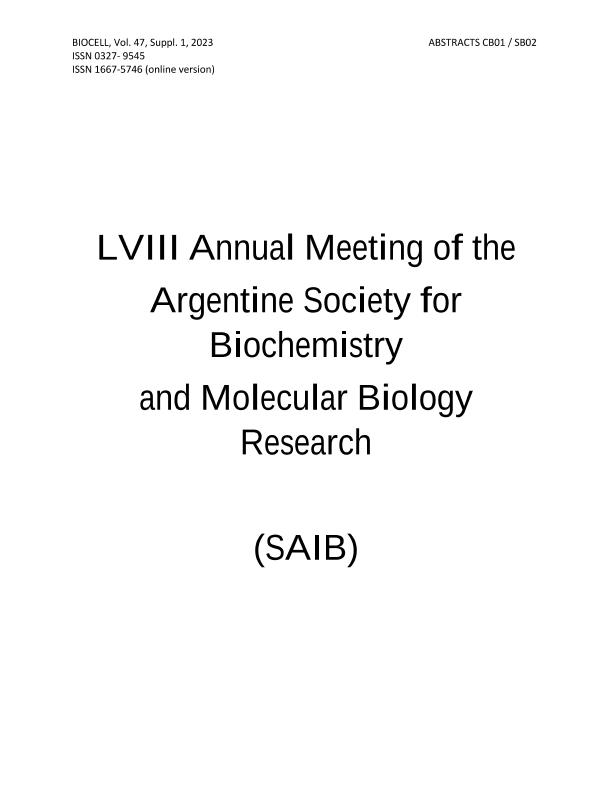Mostrar el registro sencillo del ítem
dc.contributor.author
Principe, Gabriel

dc.contributor.author
Lezcano, Virginia Alicia

dc.contributor.author
Tiburzi, Silvina Mabel

dc.contributor.author
Miravalles, Alicia Beatriz

dc.contributor.author
Montiel Schneider, María Gabriela

dc.contributor.author
Lassalle, Verónica Leticia

dc.contributor.author
González Pardo, María Verónica

dc.contributor.other
Ceccarelli, Eduardo Augusto

dc.date.available
2024-02-27T15:51:27Z
dc.date.issued
2022
dc.identifier.citation
Characterization and biological action of polyethylene glycol-coated magnetite nanoparticles in a cellular model of viral oncogenesis; LVIII Annual Meeting of the Argentine Society for Biochemistry and Molecular Biology Research (SAIB); Mendoza; Argentina; 2022; 1-2
dc.identifier.uri
http://hdl.handle.net/11336/228657
dc.description.abstract
Magnetic nanotheranostics represent promising alternatives to the traditional diagnostic and treatment procedures available for different pathologies. The goal of this work was to analyze the biological action of polyethylene glycol-coated iron oxide nanoparticles (MAG.PEG) to generate a non-toxic carrier to optimize the delivery of drugs for Kaposi?s sarcoma treatment. The MAG.PEG were synthesized by the hydrothermal method displaying a hydrodynamic diameter of 204 nm and a zeta potential of -22.1 mV. Firstly, MAG.PEG effects on cytotoxicity and cell viability were evaluated on endothelial cells expressing vGPCR, which prompts Kaposi?s sarcoma. By Trypan blue technique, we found that the incubation of these cells neither with MAG nor MAG.PEG (1-150 μg/ml) provoked significant changes in the number of living cells. In addition, cell viability analyzes (MTS and neutral red) revealed that a significant increase in metabolic and lysosomal activity was detected at higher concentrations of MAG or MAG.PEG (100-150 μg/ml) after 48 h of incubation. Secondly, the localization and accumulation of MAG.PEG (1-150 μg/ml) towards the cells was observed directly under a phase contrast microscope. In addition, MAG.PEG assembled within or nearby the cells and cell morphology remained unchanged regardless of the nanoparticles concentration. Furthermore, the presence of vesicles containing MAG.PEG inside vGPCR cells was confirmed by transmission electron microscopy. Thirdly, the iron content quantified by Prussian blue staining showed that the degree of accumulation of MAG.PEG depends on the concentration used. Finally, to steer the MAG.PEG to certain localization in the cell culture, a magnetic field generated by a moderated power magnet was used. The results indicated that the magnetic stimuli induced MAG.PEG accumulation in the zone where the magnet was placed. In conclusion, concentrations between 1 and 50 μg/ml of MAG.PEG would be suitable as drug carriers in this cellular model since no alterations in cell proliferation and viability were observed under the tested conditions. In addition, targeting MAG.PEG to a tumor with a magnet would avoid adverse effects on normal tissues.
dc.format
application/pdf
dc.language.iso
eng
dc.publisher
Tech Science Press

dc.relation
https://newsite.saib.org.ar/congreso2022/
dc.rights
info:eu-repo/semantics/openAccess
dc.rights.uri
https://creativecommons.org/licenses/by-nc-sa/2.5/ar/
dc.subject
NANOTECHNOLOGY
dc.subject
DRUG CARRIER
dc.subject
PEGYLATION
dc.subject
Fe3O4
dc.subject.classification
Bioquímica y Biología Molecular

dc.subject.classification
Ciencias Biológicas

dc.subject.classification
CIENCIAS NATURALES Y EXACTAS

dc.title
Characterization and biological action of polyethylene glycol-coated magnetite nanoparticles in a cellular model of viral oncogenesis
dc.type
info:eu-repo/semantics/publishedVersion
dc.type
info:eu-repo/semantics/conferenceObject
dc.type
info:ar-repo/semantics/documento de conferencia
dc.date.updated
2024-02-22T13:56:43Z
dc.identifier.eissn
1667-5746
dc.journal.volume
47
dc.journal.number
1
dc.journal.pagination
1-2
dc.journal.pais
Estados Unidos

dc.journal.ciudad
Henderson
dc.description.fil
Fil: Principe, Gabriel. Consejo Nacional de Investigaciones Científicas y Técnicas. Centro Científico Tecnológico Conicet - Bahía Blanca. Instituto de Ciencias Biológicas y Biomédicas del Sur. Universidad Nacional del Sur. Departamento de Biología, Bioquímica y Farmacia. Instituto de Ciencias Biológicas y Biomédicas del Sur; Argentina
dc.description.fil
Fil: Lezcano, Virginia Alicia. Consejo Nacional de Investigaciones Científicas y Técnicas. Centro Científico Tecnológico Conicet - Bahía Blanca. Instituto de Ciencias Biológicas y Biomédicas del Sur. Universidad Nacional del Sur. Departamento de Biología, Bioquímica y Farmacia. Instituto de Ciencias Biológicas y Biomédicas del Sur; Argentina
dc.description.fil
Fil: Tiburzi, Silvina Mabel. Consejo Nacional de Investigaciones Científicas y Técnicas. Centro Científico Tecnológico Conicet - Bahía Blanca. Instituto de Ciencias Biológicas y Biomédicas del Sur. Universidad Nacional del Sur. Departamento de Biología, Bioquímica y Farmacia. Instituto de Ciencias Biológicas y Biomédicas del Sur; Argentina
dc.description.fil
Fil: Miravalles, Alicia Beatriz. Universidad Nacional del Sur. Departamento de Biología, Bioquímica y Farmacia; Argentina
dc.description.fil
Fil: Montiel Schneider, María Gabriela. Consejo Nacional de Investigaciones Científicas y Técnicas. Centro Científico Tecnológico Conicet - Bahía Blanca. Instituto de Química del Sur. Universidad Nacional del Sur. Departamento de Química. Instituto de Química del Sur; Argentina
dc.description.fil
Fil: Lassalle, Verónica Leticia. Consejo Nacional de Investigaciones Científicas y Técnicas. Centro Científico Tecnológico Conicet - Bahía Blanca. Instituto de Química del Sur. Universidad Nacional del Sur. Departamento de Química. Instituto de Química del Sur; Argentina
dc.description.fil
Fil: González Pardo, María Verónica. Consejo Nacional de Investigaciones Científicas y Técnicas. Centro Científico Tecnológico Conicet - Bahía Blanca. Instituto de Ciencias Biológicas y Biomédicas del Sur. Universidad Nacional del Sur. Departamento de Biología, Bioquímica y Farmacia. Instituto de Ciencias Biológicas y Biomédicas del Sur; Argentina
dc.relation.alternativeid
info:eu-repo/semantics/altIdentifier/url/https://www.techscience.com/biocell/v47nSuppl.1/50703
dc.conicet.rol
Autor

dc.conicet.rol
Autor

dc.conicet.rol
Autor

dc.conicet.rol
Autor

dc.conicet.rol
Autor

dc.conicet.rol
Autor

dc.conicet.rol
Autor

dc.conicet.nroedicion
1
dc.coverage
Nacional
dc.type.subtype
Congreso
dc.description.nombreEvento
LVIII Annual Meeting of the Argentine Society for Biochemistry and Molecular Biology Research (SAIB)
dc.date.evento
2022-11-08
dc.description.ciudadEvento
Mendoza
dc.description.paisEvento
Argentina

dc.type.publicacion
Journal
dc.description.institucionOrganizadora
Sociedad Argentina de Investigaciones en Bioquímica y Biología Molecular
dc.source.revista
Biocell

dc.date.eventoHasta
2022-11-12
dc.type
Congreso
Archivos asociados
